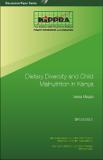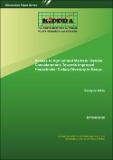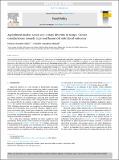| dc.description.abstract | Malnutrition in children below the age of five years is critical due to the
developmental requirements of that age. Dietary intake and diseases are the
immediate causes of malnutrition, which are influenced by food security of a
household, the child caring practices, and the environment within which the
child lives. In Kenya, the determinants of child malnutrition have been studied
extensively, and various factors such as maternal education, socio-economic
status and inadequate access to food have been analyzed. However, work on
dietary intake by children, especially using dietary diversity scores, has not been
exhaustively studied. This study aimed at analyzing dietary diversity in Kenya
and its impact on child malnutrition. The main objectives of the study are to determine the level of dietary diversity in children aged 6-59 months in Kenya, and to analyze the impact of dietary
diversity on child malnutrition. Data from the Kenya Demographic Health
Survey (KDHS) 2008/09 was used, from which the nutritional status and dietary
diversity variables were derived. Forty two (42) per cent of the children had
low dietary diversity, while 41 per cent and 17 per cent had medium and high
dietary diversity, respectively. | en |




